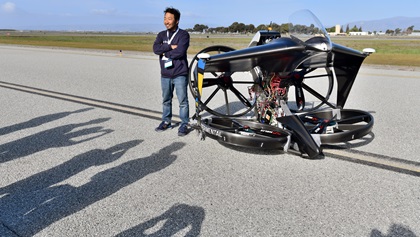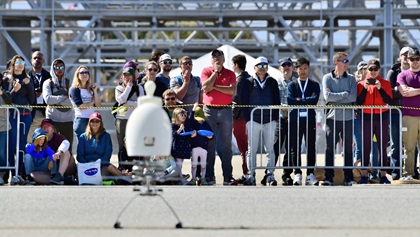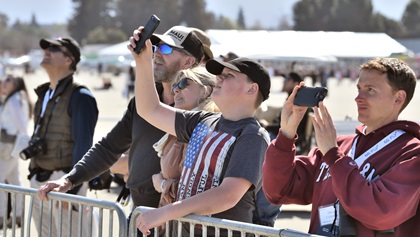$1M GoFly Prize remains unclaimed
Japan’s teTra earns $100K Disruptor award
The GoFly Prize’s Final Fly Off, in which five teams selected for Phase II competed for the $1 million grand prize, was held at NASA’s Moffett Federal Airfield in Mountain View, California, February 27 to 29.
And with the event concluded, the $1 million prize remains on the table. None of the teams that won GoFly’s Phase II, or any aspiring challengers, has been able to meet the GoFly Prize requirements. However, one team from Japan was thrilled to win the $100,000 Disruptor award, presented by engine manufacturer Pratt & Whitney.
The challenge has drawn 854 teams comprising more than 3,800 innovators from 103 countries. Designs run the gamut from flying cars, flying motorcycles, hoverboards, and jetpacks to human-carrying drones and other designs. Teams have been refining and testing scale models as well as larger unmanned, mannequin-bearing, and even manned machines. The $1 million GoFly Prize originally was to be awarded at a Final Fly Off event in October 2019, which was postponed to February 2020.
Although the grand prize has not yet been awarded, it’s apparent from talking with the teams that the GoFly competition has accelerated the development of related technology. Several teams said they made significant design changes during GoFly’s final phase, as they learned more from testing earlier iterations. And at least one team logged numerous successful flights carrying a person, but a malfunction resulting in a hard landing earlier in the week disqualified them from flying for the prize—even though the aircraft was quickly repaired and subsequently flown.

The teTra Aviation team from Tokyo won the $100,000 Pratt & Whitney Disruptor Award in what organizers have begun calling the Inaugural GoFly Prize Final Fly Off with its teTra 3 machine. “We are thrilled to announce that teTra Aviation is the winner of the Pratt & Whitney Disruptor Award,” Gwen Lighter said at the February 29 award ceremony. “The team displayed the technical design and creative prowess that we set out to inspire when we created the GoFly Prize. teTra created a unique personal flyer and we look forward to supporting them as they take the next steps towards revolutionizing human mobility.”
“Innovation has always been at the core of our DNA at Pratt & Whitney and we applaud GoFly’s efforts to transform the industry,” said Geoff Hunt, Pratt & Whitney senior vice president of engineering. “We designed the Disruptor Award to recognize the team that challenged the status quo, delivered unique thinking into a complex issue and considered safety, reliability, durability, and system integration.”
“This is beyond my imagination,” said Tasuku Nakai, teTra Aviation team captain and a doctoral student at the University of Tokyo. “The whole team is glad to celebrate this achievement. Personal flying is the future of transportation and I know there will be a day when every person will be able to take off and land anywhere.”

The angles of the four fixed rotors differentiate Team teTra’s design, making it easier for the aircraft to transition between vertical and forward flight, explained Pritish Tripathy Debasis, an electronics research and development engineer for the team. Two rotors thrust upward, while the other two are angled forward. “It is always flying in both modes,” he said, adding that the design’s wing also provides some lift, increasing efficiency in forward flight.
Debasis said teTra might fly in about eight months. “We don’t want to rush,” he said.
DragonAir Aviation has successfully flown a person, but could not complete in the Fly Off. “I think we have an excellent chance of winning. The guys have been working really hard. But that’s not what it’s all about,” said Mariah Cain, who leads DragonAir and is its pilot, on February 29. “We’re just happy to be here.”
Her team endured a three-day drive to California from Panama City Beach, Florida, and then had to perform an airworthiness demonstration. “We had a malfunction and a pretty rough landing that took us out of the competition,” she explained. From the information available, it appears that DragonAir has logged more manned flight time than any of the other GoFly competitors. Cain and her team were immediately able to identify the defect; repairs required welding some replacement aluminum; then they passed a validation flight that would have allowed them to perform a demonstration at the GoFly event—but winds Saturday were variable around 16 knots, and no demonstration flights were able to take place.

“The GoFly Prize is a great stepping stone, and a great way to get our name out. But it’s not the end game for DragonAir,” Cain said. After GoFly she said she and her team will redesign the Airboard and build 10 aircraft.
While many of the GoFly teams are self-funded, others have sponsors, and a few indicated venture-capital investment. The venture capital market is looking closely at this segment of the aviation industry, and representatives of several venture capital firms were on hand at the GoFly Final Fly Off.
The GoFly Prize is supported by Boeing, the grand prize sponsor; Pratt & Whitney, the Disruptor Award sponsor; and more than 20 national and international aviation and innovation organizations. All participating teams also benefited from the guidance and expertise of a dedicated Mentors and Masters program. All 54 Master Lectures are available online.
“The grand prize is still up for grabs,” Lighter said. “We’re not changing the rules.” Information on next steps will be announced, she added. “Defying gravity is incredibly hard. I hope that 20 years from now, we are all flying like Superman and Harry Potter.”
Look for more about the GoFly Prize on AOPA Live and in a future issue of AOPA Pilot magazine.
















